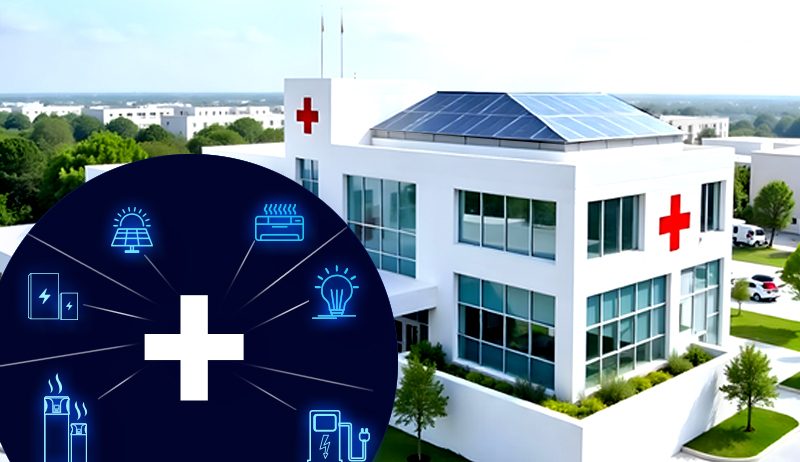Australia is witnessing a transformative shift in how energy is produced and consumed, and one of the most promising sectors experiencing this evolution is healthcare. So, how is renewable energy impacting healthcare in Australia?
Renewable energy is no longer just an environmental imperative; it rapidly contributes to nationwide sustainability, cost-efficiency, and reliability of healthcare services.
As healthcare facilities look to reduce their carbon footprints while ensuring uninterrupted service, integrating renewable energy sources like solar, wind, and hydro is reshaping the landscape of Australian healthcare.
In this blog post:
- The Urgency of Sustainability in Australian Healthcare
- Government Support and Policy Frameworks
- Solar Energy: Powering Hospitals Sustainably
- Wind and Hydro: Expanding the Renewable Mix
- Battery Storage: A Game-Changer for Energy Reliability
- Environmental and Health Co-benefits
- Operational and Financial Advantages
- Challenges and Solutions
- The Road Ahead: A Green Healthcare Future
- Medical Community's Call for Action
- How Cyanergy’s Commercial Solar Solutions Can Support the Healthcare Sector
The Urgency of Sustainability in Australian Healthcare
Healthcare is one of the most energy-intensive sectors globally. Hospitals operate 24/7, requiring consistent power for lighting, air conditioning, sterilisation, refrigeration, and advanced medical equipment.
In Australia, the healthcare sector is estimated to contribute roughly 7% of the country’s total carbon emissions. This statistic has triggered a sense of urgency to explore cleaner, more sustainable energy solutions.
Government Support and Policy Frameworks
The Australian government has introduced several initiatives and funding programs to accelerate the adoption of renewable energy in public and private healthcare facilities. Key policies and programs include:
- The Renewable Energy Target (RET): Encourages investment in clean energy.
- Clean Energy Finance Corporation (CEFC): Provides financing to renewable energy projects, including those in the healthcare sector.
- State-level health and energy strategies: States like Victoria and New South Wales have committed to zero-emission healthcare goals by 2050.
These frameworks have empowered hospitals and healthcare networks to invest in long-term, sustainable infrastructure.
Solar Energy: Powering Hospitals Sustainably
A Popular Choice Among Australian Hospitals
Solar photovoltaic (PV) systems are among the Australian healthcare sector’s most commonly adopted renewable energy solutions. These systems are relatively easy to install on hospital rooftops, car parks, and unused land.
Some examples include:
- Monash Health (Victoria): Installed solar PV systems across multiple campuses, reducing annual carbon emissions by thousands of tonnes.
- The Sunshine Coast University Hospital (Queensland) uses solar panels integrated into its energy management system, significantly cutting down electricity costs.
Benefits of Solar Adoption in Healthcare
- Cost savings: Long-term reductions in energy bills allow for budget reallocation to core services.
- Energy resilience: Commercial Solar panels and battery storage can provide backup during power outages.
- Environmental impact: A substantial decrease in greenhouse gas emissions.

Wind and Hydro: Expanding the Renewable Mix
While solar leads the way, wind and hydroelectric power are also being integrated, especially in regional and rural healthcare facilities.
Wind Energy in Rural Healthcare
- Rural hospitals in South Australia and Tasmania are experimenting with small-scale wind turbines to supplement their energy needs.
- Wind power complements solar by providing energy during nighttime or cloudy days, ensuring a continuous power supply.
Hydroelectric Support Systems
Though less common due to geographical constraints, some healthcare campuses near rivers or water sources have begun leveraging micro-hydro systems for clean energy. These systems are particularly effective in mountainous regions like New South Wales.
Battery Storage: A Game-Changer for Energy Reliability
Integrating renewable energy with battery storage ensures a consistent power supply, a critical factor in healthcare where even a brief power outage can be life-threatening.
Real-World Implementations
- Northern Adelaide Local Health Network (NALHN): Implemented battery storage to stabilise its solar energy use and provide emergency backup power.
- Alice Springs Hospital: Uses a hybrid solar-battery system to maintain energy independence and reduce diesel generator reliance.
Battery storage enhances reliability and facilitates load balancing, grid independence, and peak-shaving, reducing further costs.
Environmental and Health Co-benefits
The shift to renewable energy in healthcare doesn’t just help the environment—it directly benefits public health.
Air Quality Improvements
- Reduced fossil fuel use leads to lower air pollution levels.
- Better air quality is linked to reduced asthma, respiratory diseases, and cardiovascular disease rates.
Mitigating Climate Change
Healthcare facilities powered by renewable energy contribute less to global warming, helping mitigate extreme weather events that often strain hospital systems.
Operational and Financial Advantages
Reduced Operational Costs
Switching to renewable energy significantly lowers electricity expenses, allowing hospitals to redirect funds towards improving patient care, hiring additional staff, or upgrading medical technology.
Funding and Incentives
Government grants, green loans, and rebates help offset the initial capital cost of renewable infrastructure, making it more accessible to even small community healthcare centres.
Increased Energy Independence
By producing their power, healthcare institutions become less dependent on the national grid, reducing vulnerability to price fluctuations and energy crises.

Challenges and Solutions
While the benefits are substantial, integrating renewable energy into healthcare is challenging.
High Upfront Costs
- Challenge: The initial investment can be significant.
- Solution: Leveraging government grants, private financing, and partnerships with energy companies helps manage costs.
Infrastructure Limitations
- Challenge: Older buildings may not support solar panels or wind turbines.
- Solution: Energy audits and retrofitting projects are essential for adapting existing infrastructure.
Regulatory Hurdles
- Challenge: Navigating through energy regulations can be complex.
- Solution: Healthcare administrators often collaborate with energy consultants to streamline the process.
The Road Ahead: A Green Healthcare Future
Australia’s journey toward sustainable healthcare through renewable energy is just beginning. With growing public awareness, technological advancements, and supportive policies, the integration of renewables in healthcare is set to accelerate.
Future Trends to Watch
- Smart Grids: Real-time energy management to optimise renewable use.
- Green Building Certifications: More hospitals aim for NABERS or Green Star ratings.
- Telehealth Powered by Renewables: As digital healthcare grows, energy-efficient and renewable-powered IT infrastructure will become crucial.
Medical Community's Call for Action
Doctors and healthcare professionals across Australia are not just passive observers in the renewable energy transition—they are becoming vocal advocates.
Many leading physicians and medical associations strongly urge the Federal and State Governments to accelerate their support for renewable energy.
Their argument is twofold:
1. Protecting Public Health:
2. Climate Change Preparedness:
Extreme weather events like bushfires, heatwaves, and floods—exacerbated by climate change—overwhelm emergency and healthcare services. Doctors stress that renewable energy is key in combating climate change and building a resilient health system.
Prominent organisations like the Australian Medical Association (AMA) and Doctors for the Environment Australia (DEA) have consistently issued policy statements urging immediate action.
They highlight that investing in renewable energy is good for the planet and a vital prescription for the nation’s health.
Renewable energy is revolutionising healthcare in Australia by making it more sustainable, cost-effective, and resilient.
From commercial solar panels on rooftops to advanced battery storage systems, the shift toward clean energy is an environmental necessity and a strategic move to enhance healthcare delivery.
As challenges are addressed and innovations emerge, renewable energy and healthcare synergy promise a healthier planet and population.
This green healthcare transformation is achievable and essential for a country like Australia, which is rich in sun, wind, and innovation.
How Cyanergy’s Commercial Solar Solutions Can Support the Healthcare Sector
As healthcare providers face mounting pressure to reduce costs and carbon emissions, companies like Cyanergy are pivotal in enabling that transition. Specialising in high-efficiency commercial solar systems, Cyanergy offers tailored renewable energy solutions that align perfectly with the unique energy demands of hospitals, clinics, and aged care facilities.
Cyanergy conducts in-depth energy audits and assessments to understand each facility’s usage patterns. This allows them to design solar systems that maximise energy generation while aligning with the operational needs of healthcare environments, where reliability is non-negotiable.

Energy bills are a significant part of a healthcare facility’s budget. By installing Cyanergy’s commercial solar systems, facilities can significantly reduce electricity expenses. These savings can be reinvested into patient care, technology upgrades, or staff training.
With the option to integrate battery storage solutions, Cyanergy’s systems help healthcare institutions maintain power during grid outages or emergencies. This reliability is critical in environments where every second counts and uninterrupted power can be life-saving.
Healthcare providers are increasingly held to environmental standards and ESG (Environmental, Social, Governance) goals. Cyanergy’s systems contribute to lowering carbon footprints and supporting compliance with federal and state sustainability targets.
Navigating renewable energy incentives can be complex. Cyanergy helps healthcare clients take full advantage of government rebates, grants, and tax benefits, making the transition to solar financially viable and strategically innovative.
Cyanergy has delivered successful solar installations across various commercial sectors, including aged care and health services. Their experience ensures seamless installation with minimal disruption to day-to-day operations.
Cyanergy is not just selling solar panels—they are enabling a healthier, greener, and more cost-efficient future for Australian healthcare.
Get a free solar quote or talk to an expert today!







